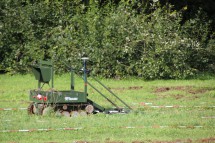UXOs
Unexploded Ordnance (or UXOs), sometimes known by the acronym of UOs or UXBs, are explosive weapons (bombs, bullets, shells, grenades, land mines, naval mines, etc.) that have not exploded since they were first used during conflicts, and therefore still pose a risk of detonation, potentially many decades after they were deployed in attacks or discarded.
Unexploded Ordnance dating from at least as far back as the American Civil War era still present hazard in many areas worldwide, in countries where there are ongoing conflicts, as sites of former battles, and on military firing ranges. A major problem with UXOs is that over the years the detonator and main charge deteriorate, often making them more sensitive to any kind of disturbance, and therefore more dangerous to handle. There are countless examples of civilians tampering with UXOs - often with fatal results. Believing the objects to be harmless, a person may unwittingly pick up the device which could explode, killing or severely injuring them. For this reason it is universally recommended that UXOs should not be touched or handled unless they are trained demining professionals. Instead, the location of any UXOs should be reported to the local police so that Bomb Disposal experts or Explosive Ordnance Disposal (EOD) professionals can remove it safely.
Although professional EOD personnel have expert knowledge, skills and equipment, they are not immune to being maimed or killed by UXOs because of the inherent dangers in undertaking their work: in June 2010, construction workers in Göttingen, Germany discovered an allied bomb weighing 500 kilograms (1,100 lb) dating from World War II and buried approximately 7 metres (23 ft) below the ground. German EOD experts were notified and attended the scene. Whilst residents living nearby were being evacuated and the EOD personnel were preparing to disarm the bomb, it detonated, killing three of them and injuring six others. The dead and injured each had over twenty years of hands-on experience, and had previously rendered safe between 600 and 700 unexploded bombs. The bomb which killed and injured the EOD personnel was of a particularly dangerous type because it was fitted with a delayed-action chemical fuse, which had become highly unstable after being buried underground for more than 65 years.
A dramatic example of the UXO threat is the wreck of the SS Richard Montgomery off the coast of Kent, which still contains 3000 tonnes of munitions. When a similar World War II wreck, the Polish Kielce exploded in 1967, it produced an earth tremor measuring 4.5 on the Richter scale.




